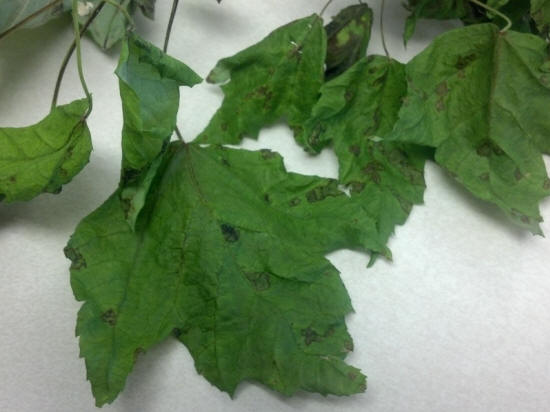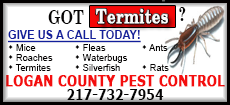|

Anthracnose on Maple
Column
Leaf Problems on Shade Trees
By John Fulton
 Send a link to a friend
Send a link to a friend
[May 31, 2016]
Here we go again! It seems every May
many area homeowners are reporting problems with their maple trees,
and this year is certainly no exception. Many times the problems
begin on one side of the tree, and have the symptoms of brown or
dropped leaves. What could be the problem? Well, anthracnose is back
again.
|
|
 Whatís anthracnose? Itís a disease caused by a fungus. Itís
present most years, and affects many different plants. On trees,
get this, it only affects good quality shade trees. That
includes maples, oaks, ash, and especially sycamores. Silver
maples are not affected by anthracnose, but are affected by
other leaf spot fungi (thatís plural for fungus). Whatís anthracnose? Itís a disease caused by a fungus. Itís
present most years, and affects many different plants. On trees,
get this, it only affects good quality shade trees. That
includes maples, oaks, ash, and especially sycamores. Silver
maples are not affected by anthracnose, but are affected by
other leaf spot fungi (thatís plural for fungus).
Anthracnose can affect three different ways on shade trees. The
first way is by affecting small twigs. In this type of
infection, small twigs are actually killed by the fungus. The
second way is affecting buds. In bud infections, the buds are
killed. The third way is infecting leaves. The leaf stage is the
most common, and shows up as dead areas along the tips and edges
of leaves or as dead spots between the leaf veins. As these dead
areas get larger, the leaves fall to the ground.


Anthracnose on Sycamore
There is no cure for anthracnose. Once the fungus has infected
the tree, we just have to ride it out. We might have prevented
the disease by protecting new buds and leaves before the
infection, but that isnít very practical on very large trees.
This would take a fungicide application covering the entire tree
every 10 days or so from when leaves first expand from the buds,
until nighttime temperatures stay over 65 degrees.
That leaves us with good news and bad news. First, the bad news
is the infections are just starting and will get worse. There is
nothing we can do but keep the trees in good growing condition
(water when dry and add a little fertilizer).
[to top of second column] |

We can continue to have leaves infected for quite some time. The
good news is that rarely is the disease a killer on established
trees. Generally the worst that happens is the loss of the small
twigs if that stage was infected, or having a bare tree in your
yard for a few weeks. I say a few weeks because generally when
leaf drop is severe, a new set of leaves comes out within 4-6
weeks.
What usually happens is it takes more energy to shoot a second set
of leaves, so that is why the water and fertilizer can be
important. Fertilizing at the same rate as lawns provides a
pound of nitrogen per 1000 square feet. That means using about 8
pounds of a 12-12-12 or 13-13-13 product per 1000 square feet.
If you are fertilizing the lawn, or flower beds or other areas,
then you are providing the fertilizer for the trees. In the case
of trees, you measure drip area, which is the area covered by
the branches. It is easiest to square it off, so a tree having a
bit over 30 foot branch spread would be 1000 square foot of drip
area. Then just spread, or scatter, the fertilizer on the area
covered by branches.
[By JOHN FULTON, COUNTY EXTENSION
DIRECTOR SERVING LOGAN, MENARD, AND SANGAMON COUNTIES]

 |